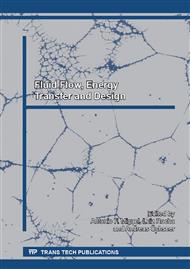[1]
J. Dooley, K.S. Hyun, K. Hughes, An experimental study on the effect of polymer viscoelasticity on layer rearrangement in coextruded structures, Polym. Eng. Sci. 38 (1998) 1060-1071.
DOI: 10.1002/pen.10274
Google Scholar
[2]
A.J. Chorin, Numerical solution of Navier-Stokes equation, Math. Comp. 22 (1968) 745-762.
DOI: 10.1090/s0025-5718-1968-0242392-2
Google Scholar
[3]
J.B. Perot, An analysis of the fractional step method, J. Comput. Phys. 108 (1993) 51-58.
Google Scholar
[4]
M. -J. Ni, M.A. Abdou, A bridge between projection methods and SIMPLE type methods for incompressible Navier-Stokes equations, Int. J. Numer. Meth. Engng. 72 (2007) 1490-1512.
DOI: 10.1002/nme.2054
Google Scholar
[5]
S. Turek, A comparative study of time-stepping techniques for the incompressible Navier-Stokes equations: from fully implicit non-linear schemes to semi-implicit projection methods, Int. J. Numer. Methods Fluids 22 (1996) 987-1011.
DOI: 10.1002/(sici)1097-0363(19960530)22:10<987::aid-fld394>3.0.co;2-7
Google Scholar
[6]
J.K. Dukowicz, Approximate factorization as a high order splitting for the implicit incompressible flow equations, J. Comput. Phys. 102 (1992) 336-347.
DOI: 10.1016/0021-9991(92)90376-a
Google Scholar
[7]
D.L. Brown, R. Cortez, M.L. Minion, Accurate projection methods for the incompressible Navier–Stokes equations, J. Comput. Phys. 168 (2001) 464–499.
DOI: 10.1006/jcph.2001.6715
Google Scholar
[8]
W. Chang, F. Giraldo, J.B. Perot, Analysis of the exact fractional step method, J. Comput. Phys. 180 (2002) 183-199.
DOI: 10.1006/jcph.2002.7087
Google Scholar
[9]
R. Kupferman, A central-difference scheme for a pure stream function formulation of the incompressible viscous flow, SIAM J. Sci. Comput. 23. 1 (2001) 1-18.
DOI: 10.1137/s1064827500373395
Google Scholar
[10]
T.L. Chow, Mathematical Methods for Physicists: A concise introduction, Cambridge University Press, Cambridge, (2000).
Google Scholar
[11]
M.A. Alves, P,J. Oliveira, F.T. Pinho, A convergent and universally bounded interpolation scheme for the treatment of advection, Int. J. Numer. Methods Fluids 41 (2003) 47-75.
DOI: 10.1002/fld.428
Google Scholar
[12]
J.E. Pilliod, E.G. Puckett, Second-order accurate volume-of-fluid algorithms for tracking material interfaces, J. Comput. Phys. 199 (2004) 465-502.
DOI: 10.1016/j.jcp.2003.12.023
Google Scholar
[13]
C.W. Hirt, B.D. Nichols, Volume of fluid (VOF) method for the dynamics of free boundaries, J. Comput. Phys. 39. 1 (1981) 201-225.
DOI: 10.1016/0021-9991(81)90145-5
Google Scholar
[14]
J.B. Bell, D.L. Marcus, A second-order projection method for variable density flows, J. Comput. Phys. 101 (1992) 334. 348.
DOI: 10.1016/0021-9991(92)90011-m
Google Scholar
[15]
E.G. Puckett, A.S. Almgren, et al., A high-order projection method for tracking fluid interfaces in variable density incompressible flows, J. Comput. Phys. 130 (1997) 269-282.
DOI: 10.1006/jcph.1996.5590
Google Scholar
[16]
P.G. Drazin, Introduction to Hydrodynamic Stability, Cambridge University Press, Cambridge, (2002).
Google Scholar
[17]
B.J. Daly, Numerical study of two fluid Rayleigh-Taylor instability, Phys. Fluids 10. 2 (1967) 297-307.
DOI: 10.1063/1.1762109
Google Scholar
[18]
G. Tryggvason, Numerical simulations of the Rayleigh-Taylor Instability, J. Comput. Phys. 75 (1988) 253-282.
Google Scholar
[19]
J. Wu, S. -T. Yu, B. -N. Jiang, Simulation of two-fluid flows by the least-squares finite element method using a continuum surface tension model, Int. J. Numer. Meth. Engng. 42 (1998) 583-600.
DOI: 10.1002/(sici)1097-0207(19980630)42:4<583::aid-nme341>3.0.co;2-m
Google Scholar
[20]
T. Nakayama, M. Mori, An Eulerian finite element method for time-dependent free surface problems in hydrodynamics, Int. J. Numer. Methods Fluids 22 (1996) 175-194.
DOI: 10.1002/(sici)1097-0363(19960215)22:3<175::aid-fld352>3.0.co;2-f
Google Scholar
[21]
S. Shin, W.I. Lee, Finite element analysis of incompressible viscous flow with moving free surface by selective volume of fluid method, Int. J. Heat Fluid Flow 21 (2000) 197-206.
DOI: 10.1016/s0142-727x(99)00083-1
Google Scholar
[22]
M.S. Kim, W.I. Lee, A new VOF-based numerical scheme for the simulation of fluid flow with free surface. Part I: New free surface-tracking algorithm and its verification, Int. J. Numer. Methods Fluids 42 (2003) 765-790.
DOI: 10.1002/fld.553
Google Scholar
[23]
J.C. Martin, W.J. Moyce, Part IV. An experimental study of the collapse of liquid columns on a rigid horizontal plane, Philos. Trans. R. Soc. London, Ser. A 244. 882 (1952) 312–324.
DOI: 10.1098/rsta.1952.0006
Google Scholar


